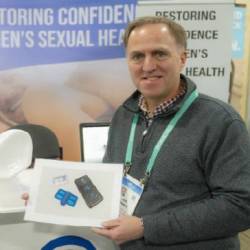Self-lubricating Condom Could Be a Safe-Sex Gamechanger
It’s about time a barrier method did more to enhance sexual pleasure.

For such an extremely well-proven way to prevent unwanted pregnancies, as well as being an effective barrier against sexually transmitted infections (STIs), condoms haven’t undergone much of a fundamental overhaul for quite some time.
Enter Boston University College of Arts & Sciences professor of chemistry and College of Engineering, Mark Grinstaff, who has led a team in developing what could possibly be a major reinvention of this barrier method.
Focusing on making condoms enjoyable
As said, condoms can be tremendously effective tools in sexual disease prevention and family planning and, according to some historians, have been doing so for as long back as the 15th century.
Here’s the thing, though, about condoms: they only work if they’re actually used.
The “whys” behind people avoiding them can be tremendously varied, from not knowing how to use them comfortably to the view that they reduce sensitivity.
The bottom line, however, is that for all their usefulness many find them less than pleasurable to use. Clearly, this can have devastating repercussions for individuals as well as the world at large.
Critically important

“Preventing the spread of HIV and other diseases is critically important. That really was the driving force for creating new technology here,” Grinstaff told Boston University’s The Brink.
The technology behind Grinstaff’s new approach to condoms is surprisingly simple: observing that many condoms repel moisture, owing often being made of latex or similar materials, he and his team worked to develop a formula that instead made the condom self-lubricating.
“We have a coating on the latex that maintains all the properties of latex. It’s durable and strong. It is a coating that when you get a thin layer of moisture on it, it becomes slippery,” he explained.
And a slippery condom, one that doesn’t need the application of outside lubrication, might be one that people would be much more willing to wear.
With help from the Bill & Melinda Gates Foundation
A critical push for Grinstaff and his team to develop their new condom came from the Bill & Melinda Gates Foundation, which has been issuing important grants to a wide range of health projects, from improving nutrition in developing countries trying to eradicate malaria—and even new ways to get condoms used more frequently and effectively.
With $100,000 from the Gates Foundation, School of Medicine professor of radiology, Ducksoo Kim, joined up with Grinstaff and soon the idea of a self-lubricating condom was on its way to becoming a practical reality.
The love for lube

Even though there are numerous types—and even flavors—of lubricants available, many even formulated for certain types of condoms, acquiring and most of all using them correctly can be daunting for many condom users.
And daunting far too often can lead to considering condom use a bother rather than a key part of responsible sexual interactions. This is another key reason why Grinstaff’s approach to condom design holds so much promise.
Yes, this self-lubricating version is more comfortable. But as it does the job itself, it makes having safe sex easier by removing that extra step: just put it on, apply a bit of natural moisture, and you’re all set to go.
On top of this, having a correctly lubricated condom can also help to prevent another problem with incorrect condom usage: that by keeping it slippery and flexible the condom will be less likely to break.
Or, as Stacy Chin, who is not just a co-author with Grinstaff on this new technology but is also the CEO of HydroGlyde Coatings, the start-up working to marketing the self-lubricating condom, put it on her company website, their goal is:
To reduce the global health challenges of STI transmission and unwanted pregnancy by promoting the correct and consistent use of condoms.
On the way to market

HydroGlyde Coatings, meanwhile, is raring to go toward putting the self-lubricating condoms in the hands of users.
Boosted by a $1.4 million funding push courtesy of the NIH Small Business Innovation Research program, the Massachusetts Life Sciences Center, plus the Massachusetts Tech Transfer Center, they are working on an eventual release in the not-too-distant future.
This all very exciting for a wide range of reasons, not the least of which is that Grinstaff and Chin might be spearheading a renaissance in reevaluating, and best of all reinventing, the old-fashioned barrier that’s long overdue for a revamp.
And, which is even better, much more enjoyable to use. As Grinstaff said, “It’s quite exciting technology.”
Image sources: bnilsen, djwings sia, Hey Paul Studios, Nils Tegmo
Leave a reply
You must be logged in to post a comment.

















